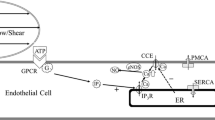Abstract.
Considering that vascular endothelial caveolae could be flow sensors converting mechanical stimuli into chemical signals transmitted into the cell, this work studied, in vitro, the change of caveolin-1 expression and distribution of cultured endothelial cells exposed to laminar flows. Experimental results showed that, in control cells, caveolin-1 were primarily localized on the cell surface, and presented some local concentrations. In cells exposed to laminar flows, caveolin-1 distribution showed a time-dependent variation. After 24 h of shear (1.0 Pa), the expression of caveolin-1 increased and a local caveolin-1 concentration was found, in most cells, at the upstream side of the cell body where the hydrostatic pressure and the spatial gradient of shear stress were at a maximum. As a comparison, tumor necrosis factor-α induced a decrease of caveolin-1 in the cells.
Similar content being viewed by others
Author information
Authors and Affiliations
Additional information
Revised version: 15 October 2001
Electronic Publication
Rights and permissions
About this article
Cite this article
Sun, .R., Muller, .S., Stoltz, .J. et al. Shear stress induces caveolin-1 translocation in cultured endothelial cells. Eur Biophys J 30, 605–611 (2002). https://doi.org/10.1007/s00249-001-0195-x
Received:
Accepted:
Issue Date:
DOI: https://doi.org/10.1007/s00249-001-0195-x




